Pandemics, Fires and then… FLOODS
By Kalpna Solanki CPHI(C) BSc MBA
I am immensely grateful to the Operators from the cities of Merritt and Kelowna for giving me a first-hand account of their experience in dealing with the aftermath of the floods that had a severe impact on the city of Merritt. This is their story. They are the heroes.
When the atmospheric river hit the BC coast on the 14th of November 2021, the Coldwater River rose to unprecedented levels, breached its banks ahead of the designed spillway, and flooded the city of Merritt. Normally, the river flows are around 25 m³/s flood levels but in this case, they peaked at 750 m³/s. The level of the river normally is around 1.197 m but this time, at peak were 3.473 m – the water levels went up 2.276 m! This resulted in Merritt losing all its infrastructure for water and sewer systems, overloading of the wastewater treatment facility and losing all infiltration basins, with raw wastewater running into river. In addition, there was a major break in the water distribution system resulting in the loss of all water from one reservoir. Fortunately, the other two reservoirs were isolated before they lost any water. As if that wasn’t bad enough, the flood water also flooded Merritt’s two pumphouses – Voght pumphouse and GE pumphouse.
Neighbouring municipalities provided support
It was all hands-on deck with Merritt’s own 21 workers as well as staff from:
1. Kamloops Crew and Equipment – 15
- 2 supervisors
- 3 Operators for the treatment plant
- 6 utilities workers to install valves and fix leaks
- 4 CCTV and flushing Operators
2. Kelowna Crew – 12
- 4 WWTP Operators
- 8 Utilities workers (flushing and repairs)
3. Black Mountain Irrigation
- 5 Utilities workers (flushing)
4. Logan Lake
- 2 Utilities workers (flushing)
- Retired supervisors – 2 (Utilities and Shop supervisors)
5. CGL Contracting – Full crew
How was the assistance deployed?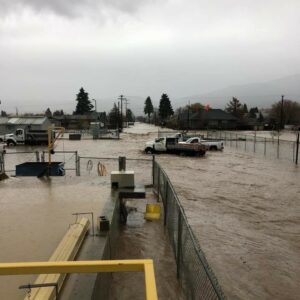
In the instance of Kamloops, the request was from the CAO of Merritt to the CAO of Kamloops to provide support. In the instance of Kelowna, the recommendation was from staff to senior management that the city should provide support and senior management then paved the way to deploy a team to Merritt.
Staff member selection
The selection was primarily due to staff member’s expertise with water and wastewater – but this was the first time they were deployed to deal with this type of emergency. Despite not knowing what challenges they were going to face, they had a great deal of industry experience and volunteered for these roles.
Crews worked in tandem
The Merritt crew knew its systems the best and was tasked to protect and keep all major infrastructure running, which included: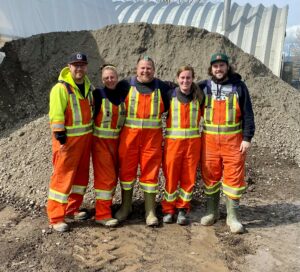
- Supervising visiting crews and cleaning of plant
- directional flushing
- isolation of potable water zones from contaminated zones
- repair of wastewater systems
- installation of new infrastructure
- fixing and repairing breaks
- locating and turning off all water services in affected areas (more than 300 services)
- turning on all water pumps
- chlorinating and de-chlorinating final effluent, and river monitoring
- 24-hour shift in WWTP for four months
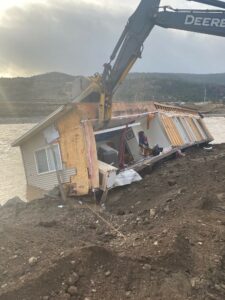 The Kamloops crew worked on fixing and installing dead-end blow-offs and installing main valves to control and repair the water system. The Kamloops CCTV crew flushed and camera sewer lines in the affected zones
The Kamloops crew worked on fixing and installing dead-end blow-offs and installing main valves to control and repair the water system. The Kamloops CCTV crew flushed and camera sewer lines in the affected zones
Working together, the Kelowna and Kamloops wastewater treatment crew worked on cleaning and putting the treatment plant operational again
Again, working together, Kelowna, Logan Lake, and Black Mountain Irrigation District crews worked on directional flushing of the whole water system
CGL Contracting installed valves, repaired a block of sewer line, and capped and installed blow offs
Equipment and supplies were brought in
Kamloops – backhoe, excavator, dump truck, vac truck, CCTV truck, two service vehicles
Kelowna – four service vehicles
Logan Lake – one service vehicle
Black Mountain Irrigation District – two service vehicles
Also, the following:
- 4” repair clamp – Kamloops installed on Grimmett St
- 6” repair clamp – CGL installed on Armstrong Street
- 6” coupler and pipe – Kelowna installed on Voght Street
- 14” valve Kamloops crew install on Priest Avenue
- 12” valve CGL installed on Nicola Avenue
- 12” tee with two valves CGL installed at Pooley Avenue and Houston Street
- 14” cap with 2” blow off installed by Kamloops at Aspen Planners mill yard by Coldwater River
- 12” cap with 2” blow off install by Kamloops on Voght Street south side of bridge
- 6” cap install on Pine St installed by CGL
- 8” sewer balls to plug sewer mains on Pine Street
- CGL also installed new sewer services and a main line on Canford Avenue and built the road back to grade.
The city of Merritt had to repair a manhole on Coldwater Avenue that created a large sinkhole that collapsed near a 4” gas main. Also needing repair was a 14” sewer main on Coldwater filled with rock and silt and had a 100% blockage.
Other equipment included PPE, winches, confined space, valve keys, hoses, wrenches, metal detectors, chlorine testers, etc.
Some lessons were learned…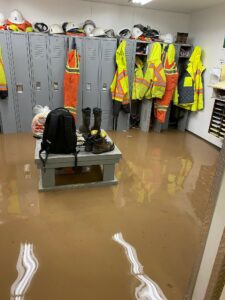
It became apparent that having accurate and updated maps and GIS systems are essential.
Crews had a difficult time finding where valves and main line where located. Over the years there wasn’t much updating of maps and valves, and even mains were moved and no records were kept.
Some valves had been forgotten and were now under asphalt. This is essential for the local crew, and even more important for those without knowledge of the system.
Several valves did not shut off completely, and hydrants needed to be used to isolate zones
Mandatory hydrant testing and maintenance is needed
- Some private hydrants did not drain and were sometimes broken. Not only do these pose a problem when there is an emergency such as the flood, but these hydrants are essentially ineffective if there is a fire.
Location
- Should locate valves a good distance from any bridge or water crossing
Equipment
- Having on hand each size of sewer plug to stop infiltration from overloading sewer line and lift stations
- A full city directional flushing program
- Proper directional flushing equipment
- Knowing the steps to super chlorinate and load a full system from using one water pump
Staffing
- The Merritt team knows its infrastructure well
- Maintaining a good working relationship with stakeholders such as the DWO was helpful
- Good communication between team members
- Cross-trained staff can work in various areas
- Reimbursement from EMBC to supporting municipalities via Disaster Financial Assistance is essential
- Whilst there are no written Mutual Aid frameworks in place, the assistance provided by neighbouring municipalities was very effective
- The crew is dedicated and committed. No-one evacuated with their family.
- This was an opportunity for crews from different cities to learn from each other
- Retired Operators can be called on to provide support
- A simple system of orange bagging valves that had been shut off was effective
- Hydrants that had been flushed were ribboned
- Staff from utilities e.g. Fortis needed to be there to support and stabilize gas lines
- Cell phones cannot be relied upon for communication. Fortunately, many had 2-way radios that could be used
- Having experienced Operators was essential. This was not the time to be learning operational skills
- Keep staff and roles consistent to reduce confusion
What could be done better?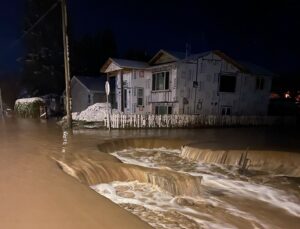
- Communication
- Determine what is needed
- Direct contact with staff at site prior to departure
- Designation of a ‘lead’ person in the affected community for each of the disciplines – WT, WD, WWC, WWT
- Emphasis on safety procedures (OH&S)
- Identification of response team
- Trained
- Roles identified
- Accurate mapping
- Awareness of ‘Safety First’ with proper safety equipment such as life jackets, ropes, tripods, PPE, etc.
- Planning
- Processes to protect main infrastructure
- Have a way to contain and dewater around all pumps and treatment plant
- Plans in place for a major infrastructure failure
- Planning and engineers need to interact with the people who know the system
- Improved knowledge of water and wastewater Operations by those in EOC for each city
- Better communication on appropriate time for residents to come back. Some residents were coming back while large scale flushing was occurring
- SOPs to deal with issues such as valve closures
- Better tracking of time and pay
- Processes in place for food and accommodation (for local crew as well as those assisting)
- Debrief including all involved after the event
- Identification of a safety coordinator
- Tailgate meetings on a regular basis
Is there a Role for the EOCP?
- Expansion of Operator Peer Network database to include skillset of Operators
- Development of an emergency plan
- Assembling of appropriate teams
- Training on Incident Command Systems for team leads
- Assist with debrief after each event to ensure better preparedness for future events
In addition to the pandemic, 2021 brought the wrath of fires and floods and tested the mettle of our Operators. With these weather events becoming more frequent and more extreme, it is apparent that we need to be better prepared. In my role as a Founding Director of Operators Without Borders and overseeing establishment of the OWB Volunteer Database, and also having undergone Incident Command System training, I know we can do more to be better prepared. Stay tuned for more updates on this.
